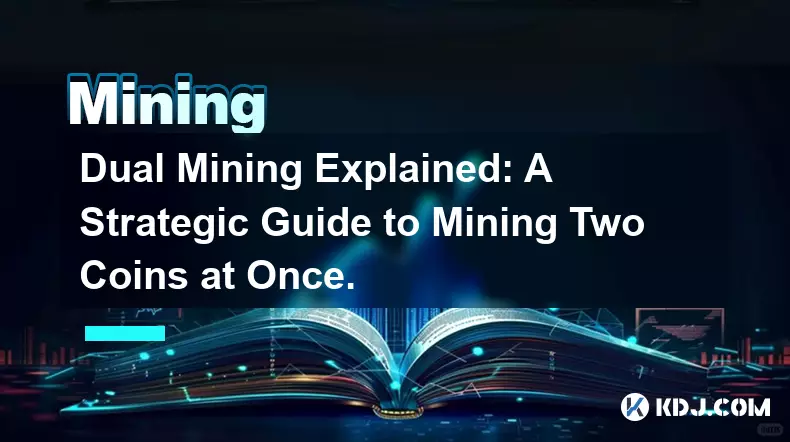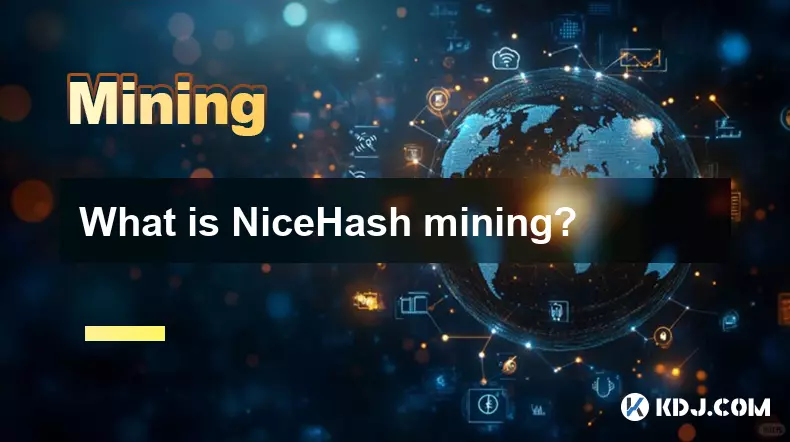-
 bitcoin
bitcoin $102877.190955 USD
1.88% -
 ethereum
ethereum $3430.435064 USD
4.52% -
 tether
tether $0.999264 USD
-0.05% -
 xrp
xrp $2.307310 USD
4.49% -
 bnb
bnb $987.740692 USD
3.82% -
 solana
solana $161.947760 USD
3.97% -
 usd-coin
usd-coin $0.999712 USD
-0.05% -
 tron
tron $0.292810 USD
2.93% -
 dogecoin
dogecoin $0.179738 USD
10.70% -
 cardano
cardano $0.580716 USD
8.75% -
 hyperliquid
hyperliquid $42.463448 USD
8.40% -
 chainlink
chainlink $15.763437 USD
7.05% -
 zcash
zcash $649.595636 USD
17.21% -
 bitcoin-cash
bitcoin-cash $511.610261 USD
7.19% -
 stellar
stellar $0.292537 USD
7.91%
Dual Mining Explained: A Strategic Guide to Mining Two Coins at Once.
Dual mining boosts profits by simultaneously mining two cryptocurrencies, but requires compatible algorithms, optimized hardware, and careful thermal management.
Nov 05, 2025 at 05:34 am

Dual Mining Explained: A Strategic Guide to Mining Two Coins at Once
1. Dual mining refers to the process of simultaneously mining two different cryptocurrencies using the same hardware setup. This technique leverages the computational power of GPUs or ASICs to contribute to two blockchain networks at once, often combining a primary coin with a secondary one that requires less intensive resources. The most common example involves mining Ethereum (or another Ethash-based coin) alongside Ravencoin, TON, or other compatible algorithms.
2. The foundation of dual mining lies in algorithm compatibility. Not all coins can be mined together due to differences in hashing mechanisms. For instance, Ethash and KawPoW are frequently paired because they allow miners to allocate unused memory bandwidth or idle processing cycles toward a secondary chain without significantly impacting the performance of the main mining operation.
3. Miners benefit from increased revenue streams by capturing block rewards from both chains. While the primary coin typically generates the bulk of earnings, the secondary coin adds incremental gains that can improve overall profitability—especially when energy costs are low or hardware is already optimized for high throughput.
4. Software solutions like TeamRedMiner, GMiner, and NBMiner support dual mining configurations. These tools enable users to input wallet addresses, pool URLs, and worker details for both coins, automatically managing hash distribution and connection stability. Configuration files must be carefully tuned to avoid crashes or reduced efficiency.
5. Power consumption remains a critical factor. Although dual mining improves output per watt, pushing hardware beyond optimal thresholds may lead to overheating or accelerated wear. Monitoring temperatures, fan speeds, and voltage settings ensures longevity and sustained performance across both mining operations.
Hardware Requirements and Optimization
1. High-memory GPUs are essential for effective dual mining, particularly when dealing with Ethash-based primary coins. Cards with 8GB or more VRAM handle DAG file growth better, reducing the risk of memory bottlenecks during simultaneous computations.
2. AMD Radeon cards have historically shown stronger support for dual mining due to better OpenCL performance and software optimization. However, recent advances in NVIDIA drivers and miner compatibility have narrowed the gap, allowing RTX 30 and 40 series GPUs to participate efficiently.
3. Overclocking and undervolting play a major role in maximizing efficiency. Adjusting core clock, memory frequency, and power limits helps balance hash rate and energy draw. Tools like MSI Afterburner or ADRENALINE Edition provide granular control over these parameters.
4. System RAM should not be overlooked. While GPU memory handles the bulk of mining tasks, sufficient system RAM (16GB or higher) prevents bottlenecks when running multiple processes or virtual machines for monitoring and management.
5. Stable internet connectivity is crucial. Dual mining requires constant communication with two separate pools. Any latency or packet loss can result in rejected shares and reduced payouts on one or both networks.
Risks and Considerations in Dual Mining
1. Increased thermal load can shorten hardware lifespan. Running GPUs at near-peak capacity for extended periods accelerates degradation, especially if cooling infrastructure is inadequate. Proper airflow, dust management, and ambient temperature control are non-negotiable.
2. Some mining pools impose restrictions on dual mining. Before configuring your rig, verify that both the primary and secondary pools accept dual-mined traffic. Unauthorized use may lead to IP bans or account suspensions.
3. Profitability fluctuates based on coin prices, network difficulty, and exchange rates. A coin that appears profitable today might drop in value tomorrow, turning what seemed like an efficient strategy into a net loss. Real-time monitoring tools help adjust strategies dynamically.
4. Firmware modifications or BIOS flashing carry inherent risks. While some miners tweak VBIOS to unlock memory timing improvements, incorrect changes can permanently damage hardware or void warranties.
5. Regulatory scrutiny around cryptocurrency mining continues to grow. Jurisdictions may impose restrictions on energy usage or require licensing for large-scale operations. Staying compliant avoids legal complications and potential shutdowns.Selecting Profitable Coin Pairs
1. Compatibility between algorithms determines viable pairs. Ethash + KawPoW, Autolykos + MTP, and Cuckoo Cycle variants are among the most supported combinations. Always confirm compatibility with your chosen mining software before deployment.
2. Market liquidity matters. Even if a secondary coin offers high block rewards, poor exchange availability limits convertibility. Prioritize coins listed on reputable exchanges with active trading pairs against BTC, ETH, or stablecoins.
3. Network difficulty trends influence long-term viability. Sudden spikes in hashrate can dilute individual rewards. Tracking historical data through explorers or analytics platforms aids in predicting sustainability.
4. Community support and development activity signal project health. Coins with active GitHub repositories, regular updates, and engaged teams are less likely to collapse unexpectedly.5. Pool fees and payout structures affect net returns. Compare minimum payout thresholds, fee percentages, and reward systems (PPS vs. FPPS vs. PROP) across different providers to identify the most favorable terms for each coin.
Frequently Asked Questions
What happens if one of the mining pools goes offline?If the secondary pool disconnects, most modern miners will continue hashing the primary coin without interruption. Some advanced setups automatically switch to backup pools or halt the secondary process until connectivity resumes.
Can I dual mine with ASICs?ASICs are generally designed for single-algorithm mining and lack the flexibility required for dual operations. Most dual mining is performed using GPUs due to their parallel processing capabilities and software adaptability.
Does dual mining reduce the lifespan of my GPU?Continuous high-load operation increases wear on components. While dual mining itself isn’t inherently more damaging than single mining, running at maximum capacity for prolonged periods raises failure risks, especially without adequate cooling.
Are there tax implications for earning two different coins?Yes. Each cryptocurrency received as a reward is typically considered taxable income at its fair market value on the date of receipt. Accurate record-keeping of mining dates, quantities, and values is essential for compliance with tax authorities.
Disclaimer:info@kdj.com
The information provided is not trading advice. kdj.com does not assume any responsibility for any investments made based on the information provided in this article. Cryptocurrencies are highly volatile and it is highly recommended that you invest with caution after thorough research!
If you believe that the content used on this website infringes your copyright, please contact us immediately (info@kdj.com) and we will delete it promptly.
- Ripple (XRP) in 2026: Hold or Fold? A Look at XRP's Future and Emerging DeFi Alternatives
- 2025-11-08 18:35:01
- Zcash ZEC Coin Price Explosion: From Privacy Niche to Center Stage
- 2025-11-08 18:55:01
- Berachain Price Prediction: Navigating the Honeycomb Hype in Crypto
- 2025-11-08 18:55:01
- Arthur Hayes, Gold, and Bitcoin: A Modern Monetary Trinity?
- 2025-11-08 19:15:01
- Shiba Inu's Next Move: Navigating a Shifting Market
- 2025-11-08 19:20:01
- Pakistan's Crypto Crossroads: Balancing Opportunity with Asset-Backed Realities
- 2025-11-08 19:20:01
Related knowledge

What is the block reward in mining?
Nov 06,2025 at 12:35am
Understanding Block Rewards in Cryptocurrency Mining1. The block reward is the incentive miners receive for successfully validating and adding a new b...

How do mining algorithms work?
Nov 06,2025 at 04:59am
Mining Algorithms and Their Role in Blockchain Networks1. Mining algorithms serve as the backbone of blockchain consensus mechanisms, ensuring that tr...

What is NiceHash mining?
Nov 06,2025 at 07:40am
NiceHash mining refers to the process of renting out computational power to individuals or organizations seeking to mine cryptocurrencies without owni...

Does an antivirus program affect mining?
Nov 05,2025 at 09:29pm
Understanding Decentralized Exchanges in the Crypto Ecosystem1. Decentralized exchanges (DEXs) operate without a central authority, allowing users to ...

What is the history of Bitcoin mining?
Nov 05,2025 at 08:15pm
Within the fast-moving world of cryptocurrency, new developments emerge daily, reshaping how investors, developers, and institutions interact with dig...

How is the energy consumption of mining justified?
Nov 05,2025 at 10:20pm
Energy Consumption in Cryptocurrency Mining1. The energy consumption associated with cryptocurrency mining has drawn significant attention from enviro...

What is the block reward in mining?
Nov 06,2025 at 12:35am
Understanding Block Rewards in Cryptocurrency Mining1. The block reward is the incentive miners receive for successfully validating and adding a new b...

How do mining algorithms work?
Nov 06,2025 at 04:59am
Mining Algorithms and Their Role in Blockchain Networks1. Mining algorithms serve as the backbone of blockchain consensus mechanisms, ensuring that tr...

What is NiceHash mining?
Nov 06,2025 at 07:40am
NiceHash mining refers to the process of renting out computational power to individuals or organizations seeking to mine cryptocurrencies without owni...

Does an antivirus program affect mining?
Nov 05,2025 at 09:29pm
Understanding Decentralized Exchanges in the Crypto Ecosystem1. Decentralized exchanges (DEXs) operate without a central authority, allowing users to ...

What is the history of Bitcoin mining?
Nov 05,2025 at 08:15pm
Within the fast-moving world of cryptocurrency, new developments emerge daily, reshaping how investors, developers, and institutions interact with dig...

How is the energy consumption of mining justified?
Nov 05,2025 at 10:20pm
Energy Consumption in Cryptocurrency Mining1. The energy consumption associated with cryptocurrency mining has drawn significant attention from enviro...
See all articles





















![The Graph Price Prediction [GRT Crypto Price News Today] The Graph Price Prediction [GRT Crypto Price News Today]](/uploads/2025/11/07/cryptocurrencies-news/videos/690d4df44fe69_image_500_375.webp)



















































